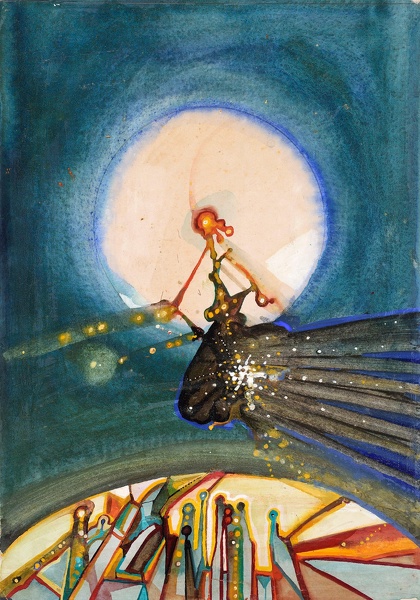
£975
Cosmo 25, late 1960's
Unmounted (ref: 8122)
Mixed media, inscribed'25'

Provenance: The Artist's Studio
Literature; David Evans, Edited by Sacha Llewellyn & Paul Liss, published by Liss Llewellyn Fine Art, 2017. ISBN 978-0-9930884-6-9, cat 124, page 163.
Early in his career Evans showed photo-montages at fashionable London restaurants such as Gallery One and gained several commissions. These included a design for the Hollywood Room in the Observer Film Exhibition, 1956, and a mural for the Soup Kitchen, Knightsbridge. Until recently Evans early work remained unrecorded - its rediscovery allows for a fuller understanding of his development as an artist.
The Cosmos series probably date to the late 1960's just before Evans left London for East Anglia( 1969). Thematically they tie up with his passion for music - during this period Evans ran a a small classical music record shop, Record Roundabout, at 29 Brompton Road. Stylistically the Cosmo series bridge Evans earlier photo montage with the the larger scale watercolours of the 1970's for which he became well known through a series of Solo exhibitions at The Redfern Gallery, (from 1979-1988).
Evans was an ardent campaigner and environmentalist. After moving to the hamlet of Dallinghoo (Suffolk) in 1969, he and his partner, Basil Lawrence, strove to become self-sufficient – his diary frequently chronicles the cultivation of vegetables and attempts to produce wine. Evans’ landscapes mirror a country-side in flux, moving from traditional small holdings to the large open fields created by modern farming methods. His compositions are occupied variously by farmers, soldiers, workmen, and the occasional rambler. Construction and military vehicles, and farm machinery, weave their way in and out of the compositions. Urban subjects, similar to the repertoire of L.S Lowry (1887-1976), unfold against a backdrop of factories, concerts halls, sporting arenas, beaches, cafeterias and bars, museum interiors and shopping centres. Bill boards, traffic congestion and fast food are very much in evidence. Night clubs are peopled predominantly by men (and the occasional drag-queen), a celebration of Evans’ homosexuality. Evans' strikingly large watercolours, (they typically measure over one metre in height or breadth), span two decades, (from the late 1960s to the late 1980s). While powerfully evoking the period charm of the glam-rock era, Evans showed a conscious awareness of the shifting political landscape around him. His compositions are characterised by a kaleidoscopic vision of Thatcher's Britain: an era of urban redevelopment, the Falklands War, industrial unrest, nuclear power, and the Cold War. Transition is everywhere: new roads carve their way through the countryside; fighter jets cast their shadows across the landscape; the scars left by industrial plants, pylons and landfill permeate throughout Evans' compositions belong to the Northern tradition of Hieronymus Bosch (1450-1516). Through heightened colour and narrative details his contemporary subjects resonate an underlying disquiet. In his love of story-telling, quirky humour and a delight in the ordinary, his pictures are also unequivocally British, especially in his commitment to producing watercolours intended for exhibition, rather than as studies for larger oil paintings. Comparison to the large, idiosyncratic watercolours of Edward Burra (1905-1976) is inevitable, but in Evans' paintings there are also other clear generational influences, from Keith Vaughan (1912-1977), by whom Evans was taught, to Peter Blake (b.1932), David Hockney (b.1937), Alan Reynolds (1926-2014), Lucian Freud (1922-2011), Francis Bacon (1909-1992), Graham Sutherland (1903-1980) and Eduardo Paolozzi (1924-2005).